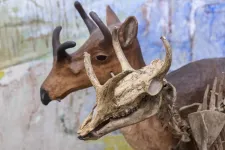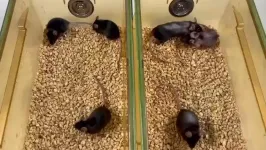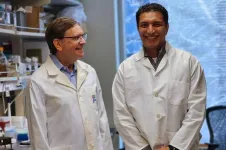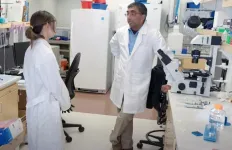(Press-News.org) When trying to understand the present, it's helpful to look to history. New research from the University of Nebraska–Lincoln examined the fossil record going back 66 million years and tracked changes to mammalian ecosystems and species diversity on the North American continent.
The study, led by Alex Shupinski, who earned her doctorate in May, and co-authored by Kate Lyons, associate professor in the School of Biological Sciences, provides a large-scale view of how species diversity changed over the first 65 million years of the Cenozoic era — up until the arrival of humans — and how climate and other environmental factors, including changing landscapes, affected animal life on the continent.
The findings published in Proceedings of the Royal Society B also provide a glimpse into how mammals rebounded following the last mass extinction event — the eradication of non-avian dinosaurs.
“Beginning 66 million years ago, we go from a completely sub-tropical environment across North America to grasslands to a frozen savanna, and finally, reaching the Ice Age,” Shupinski said. “It's showing how species changed through time, through many ecological, environmental and climatic changes and it allows us to compare across those events and at different spatial scales.”
The researchers sliced the fossil record of the Cenozoic era into million-year increments and used three indices of functional diversity — which quantifies changes in community structures using mammalian traits — to examine mammalian communities on both a local and continental scale.
For most of the Cenozoic era, local and continental measures of functional diversity differed, but surprisingly, during the first 10 million years of the era, immediately following the extinction of non-avian dinosaurs, all measures of functional diversity, both locally and across the continent, increased.
“That was fascinating to see, that for most of the Cenozoic, functional diversity was uncoupled across time and spatial scales, except this one time,” Shupinski said. “For 10 million years, all the measures are changing in the same way. Then, around 56 million years ago, we get this massive immigration of mammals into North America from other continents, and at that point, we see a divergence of functional diversity.
“Communities are changing at different times, at different rates and in different directions,” she said. “We might see locally, the diversity of roles increasing, but continentally, they’re decreasing.”
Lyons said that some of the changes among mammalian species can be explained by environmental changes, including cooling and warming periods or when heavily forested areas were usurped by grasslands, but that the large-scale environmental changes did not rise to the level of disruption caused by the mass extinction of dinosaurs.
"That is why this could potentially be a way to pinpoint areas of the globe or communities that are under particular stress,” Lyons said. “We may be entering a sixth mass extinction event, and if so, we might expect to see communities that are on the vanguard of that extinction respond in a similar way, based on the patterns we see after the extinction of the non-avian dinosaurs."
In the field of conservation paleobiology, tracking past changes in ecosystems over long periods of time helps scientists and the public better understand biodiversity crises happening today, and this current study offers a thorough analysis of the age of mammals and hints at what may come next.
“If we are looking at the modern (crises) and we see a similar response in the functional diversity of modern community structures, it may be a conservation tool as we can highlight some of these communities that are experiencing the most disturbance and that are at highest risk of change and disturbance in their ecological services and function,” Shupinski said.
Additional authors on the study are Peter Wagner, professor of Earth and atmospheric sciences at Nebraska, and Felisa Smith of the University of New Mexico, Albuquerque.
END
Research tracks 66 million years of mammalian diversity
2024-07-17
ELSE PRESS RELEASES FROM THIS DATE:
RegeneratOR Test Bed welcomes Cytoink to accelerate biomedical innovations
2024-07-17
Winston-Salem, North Carolina — July 17, 2024 — The RegeneratOR Test Bed, located in Innovation Quarter, announces the inclusion of Cytoink into its pioneering ecosystem dedicated to advancing biomedical research and development. Cytoink brings cutting-edge biomaterials manufacturing, with over 100 custom formulations, and bioprinting expertise that merges biofunctionality with high-throughput production. Cytoink specializes in the biofabrication of in vitro 3D tissue phantoms, extrusion-based and light-based (DLP/VAM) bioinks, and integrated perfusion microfluidics bioreactors. Additionally, Cytoink provides bespoke biomaterial solutions ...
Jeffrey Spraggins named director of Vanderbilt University Mass Spectrometry Research Center
2024-07-17
Jeffrey Spraggins, associate professor of cell and developmental biology, biochemistry, and chemistry, has been named director of the Mass Spectrometry Research Center. He succeeds Richard Caprioli, Stanford Moore Chair in Biochemistry, who established the MSRC in 1998 and who is retiring this summer.
Spraggins is a leading scientist in spatial biology and imaging mass spectrometry—an untargeted molecular imaging approach that enables molecular mapping at cellular resolution—a technology originated by Caprioli. Spraggins’ research lies at the intersection of technology development, data science, and biomedical research. His research group ...
Duke-NUS finding advances quest to slow ageing
2024-07-17
An ageing population will bring colossal health, social, and economic challenges over the coming decades[1]. As people live longer, staving off the physical decline and frailty that come with age has become a holy grail, with effective interventions projected to unlock significant societal and economic benefits. Estimates suggest that a slowdown in ageing that increases life expectancy by one year alone is worth US$38 trillion.[2]
In a discovery published in Nature, a team of scientists from Duke-NUS Medical School in Singapore may have found a key to slow ageing.
The ...
Logged forests can still have ecological value – if not pushed too far
2024-07-17
Researchers have analysed data from 127 studies to reveal ‘thresholds’ for when logged rainforests lose the ability to sustain themselves.
The results could widen the scope of which forests are considered ‘worth’ conserving, but also show how much logging degrades forests beyond the point of no return.
The first-of-its-kind study, led by researchers from the Department of Life Sciences at Imperial College London with collaborators from around the world, is published today in ...
Exoplanet caught in ‘hairpin turn’ signals how high-mass gas giants form
2024-07-17
UNIVERSITY PARK, Pa. — Astronomers have discovered a planet that has the most oblong orbit ever found among transiting planets. The exoplanet’s extreme circuit — which looks closer to a cucumber than a circle — follows one of the most drastically stretched-out orbits of all known exoplanets, planets that orbit stars outside our solar system. It is also orbiting its star backwards, lending insight into the mystery of how close-in massive gas planets, known as hot Jupiters, form, stabilize and evolve over time.
The research, led by Penn State scientists, was published today (July 17) in ...
Switching off inflammatory protein leads to longer, healthier lifespans in mice
2024-07-17
Scientists at the Medical Research Council Laboratory of Medical Science and Imperial College London have discovered that ‘switching off’ a protein called IL-11 can significantly increase the healthy lifespan of mice by almost 25%.
The scientists, working with colleagues at Duke-NUS Medical School in Singapore, tested the effects of IL-11 by creating mice that had the gene producing IL-11 (interleukin 11) deleted. This extended the lives of the mice by over 20% on average.
They also treated 75-week-old mice – equivalent to the age of about 55 years in humans – with an ...
New gene therapy for muscular dystrophy offers hope
2024-07-17
A new gene therapy treatment for Duchenne muscular dystrophy shows promise of not only arresting the decline of the muscles of those affected by this inherited genetic disease, but perhaps, in the future, repairing those muscles.
The UW Medicine-led research focuses on delivering a series of protein packets inside shuttle vectors to replace the defective DMD gene within the muscles. The added genetic code will then start producing dystrophin, the protein lacking in patients with muscular dystrophy.
Currently, there is no cure for the disease ...
Scientists bridge the 'valley of death' for carbon capture technologies
2024-07-17
A major obstacle for net zero technologies in combatting climate change is bridging the gap between fundamental research and its application in the real world.
This gap, sometimes referred to as ‘the valley of death’, is common in the field of carbon capture, where novel materials are used to remove carbon dioxide from flue gasses produced by industrial processes. This prevents carbon from entering the atmosphere, helping to mitigate the effects of climate change.
Chemists have proposed and ...
Genome recording makes living cells their own historians
2024-07-17
Genomes can now be entrusted to store information about a variety of transient biological events inside of living cells, as they happen, like a flight recorder collecting data from an aircraft.
“Our method, which goes by the acronym ENGRAM, aims to turn cells into their own historians,” said Dr. Jay Shendure, a professor of genome sciences at the University of Washington School of Medicine and scientific director of the Brotman Baty Institute for Precision Medicine. Shendure led the effort, together with Wei Chen, a former graduate student, and Junhong Choi, a former postdoctoral fellow. Junhong ...
USC Schaeffer Institute launches new initiative to improve public policy through behavioral science
2024-07-17
The USC Schaeffer Institute for Public Policy & Government Service announced a new initiative today that leverages behavioral science to create more effective public policy.
The Behavioral Science & Policy Initiative at the USC Schaeffer Institute will conduct research to understand people’s beliefs and behaviors to create policies and communication that better fit people’s needs. The initiative will focus on policy topics such as climate change, health, and food insecurity.
“We want to help policymakers make a difference,” said Wändi Bruine de Bruin, the initiative’s ...









